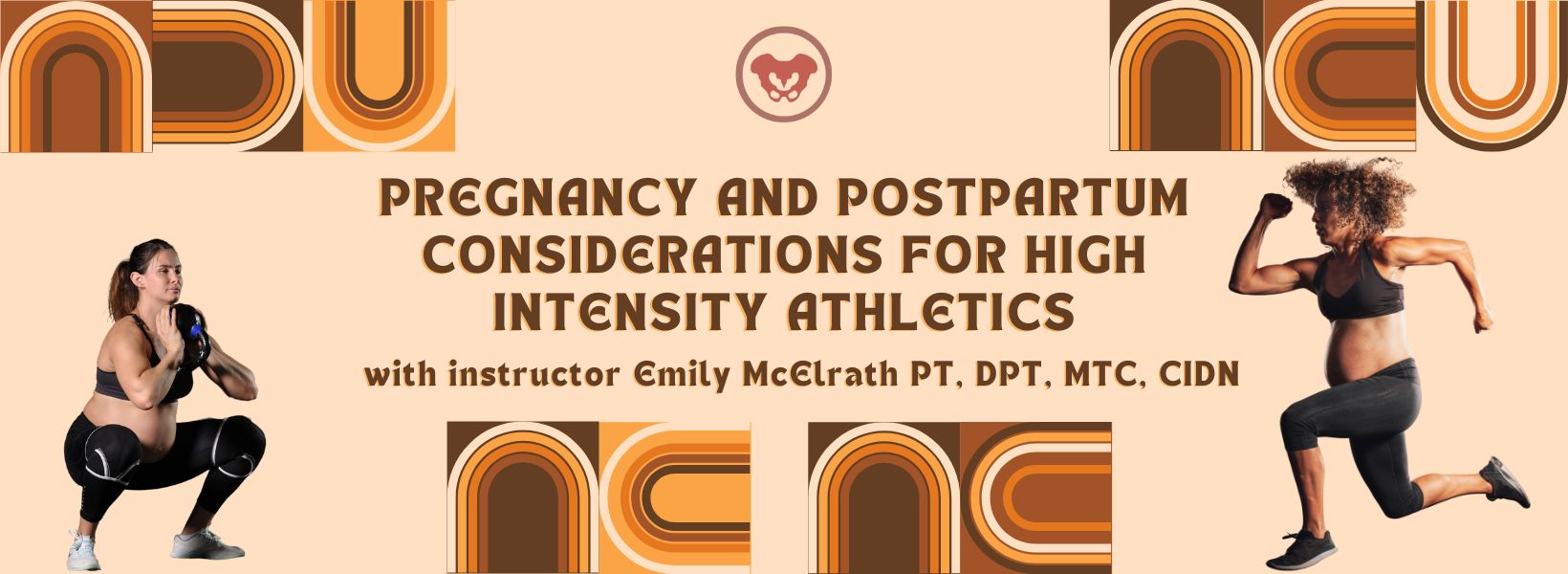Special Considerations for Pregnant and Postpartum Athletes - A Conversation with Emily McElrath

This week The Pelvic Rehab Report sat down with new faculty member, Emily McElrath PT, DPT, MTC, CIDN, to discuss her pelvic rehab journey and her new course, Pregnancy and Postpartum Considerations for High-Intensity Athletics. Emily is a native of New Orleans, is highly trained in Sports and Orthopedics, and has a passion for helping women achieve optimal sports performance. Emily is also certified in manual therapy and dry needling, which allows her to provide a wide range of treatment skills including joint and soft tissue mobilization. She is an avid runner and Crossfitter and has personal experience modifying these activities during pregnancy and postpartum.

Hi Emily! Can you tell us a little bit about yourself and your clinical practice?
My name is Emily McElrath, and I am an orthopedic and pelvic floor PT. I spent the early years of my career in sports medicine and primarily worked with high school and collegiate athletes, as well as weekend warriors. I myself am a distance runner and Crossfitter and have always had a love for sports. After the birth of my second child, I had a hard time returning to Crossfit due to significant pelvic floor dysfunction and pain. At that time, I became a pelvic floor patient and quickly realized how valuable this specialty was. This began my journey to becoming a pelvic PT.
Since that time almost 4 years ago, I have been blending my orthopedic and pelvic health knowledge and skillset to help women return to the sports they love without pain and pelvic floor dysfunction. My main goal as a clinician is to educate and empower my patients to feel in control of their own bodies, and to feel confident in daily and recreational activities.
What has your educational journey as a pelvic rehab therapist looked like and how did you get involved in the pelvic rehabilitation field?
It was really a matter of personal experience leading me to the field of pelvic health. I knew the specialty of pelvic health existed, but until I was a patient I did not truly appreciate how valuable it was. Seeing firsthand how significantly pelvic floor physical therapy could improve the quality of a patient’s life gave me a desire to become a pelvic PT. Once I got into my course work with Herman & Wallace, I realized that my background as an orthopedic PT would blend well with pelvic PT. It also gave me a lot of perspective into how significant of a role the pelvic floor plays in the entire kinetic chain. I would even say that my pelvic floor education has helped me be a more thorough orthopedic clinician. It has helped me think outside the box and enabled me to be more thorough in my critical thinking when evaluating patients.
What patient population do you find most rewarding in treating and why?
I have two patient populations that I find most rewarding. The first is HIIT athletes. I find this population so fun to work with. They are some of the most dedicated and compliant patients I have. Their love of their sport is often a driving force for them to get and stay healthy. Many of these athletes will even come to my clinic without having pain or dysfunction. They are strictly coming for education and prevention, which I love. After all, PTs as a profession are huge proponents of wellness and prevention. I also love teaching a patient that they can, in fact, continue doing exercises they may have been previously told were not safe to do during pregnancy or postpartum. Giving them hope that they can continue doing what they love after they were afraid they may not is very rewarding.
The second population I love working with is my childbirth prep patients. I LOVE education. I feel like these sessions really highlight that part of physical therapy. These sessions not only address any current concerns a patient is having but also provide education to give them the confidence to birth the way they want. I review everything from what to expect during labor, to different positions for pushing, and how to push. I even have partners come to the sessions so they can learn how to best support the patient during delivery. Hearing from patients that their birth experience was beautiful and just as they had hoped always gives me a lot of joy. I feel honored to be able to be a part of that journey.
What do you find is the most useful resource for your practice?
I find other practitioners the most valuable resource in my practice. There is so much that can be gained from collaborating with other pelvic PTs, doulas, midwives, OB/GYN, sex therapists, etc. Pelvic rehab is so multifaceted, that I believe it truly requires a collaborative approach to provide the best patient outcomes.
What books or articles have impacted you as a clinician?
There was a recent article that came out about the prevalence and significance of Levator Ani avulsion tears. This was an interesting article because I have seen this more and more clinically, but there is very little research on the matter. My favorite books as a clinician are: “The Body Keeps the Score”, “Come As You Are”, and “Pelvic Pain Explained”.
What lesson have you learned in a course, from an instructor, or from a colleague or mentor that has stayed with you?
I think the biggest thing I have learned is that the objective findings of our evaluations are only a small part of the puzzle. Pelvic rehab is an intimate type of physical therapy, and many of our patients may have had trauma that is still raw to them. If most of your evaluation is spent talking with the patients to ensure they feel comfortable, that’s ok. I have realized that it’s ok if I don’t get to every objective test and measure in the first session. In this line of work, patient comfort is most important. Building a rapport with your patient must take precedent.

What made you want to create this course, Pregnancy and Postpartum Considerations for High-Intensity Athletics?
I wanted to create this course because I saw a need in the Crossfit community for more education on how to safely train pregnant and postpartum athletes, and I feel physical therapy is a great place to start, after all, PTs are experts in the musculoskeletal system. We are seeing more and more of these HIIT athletes becoming moms and wanting to maintain their athleticism throughout pregnancy & postpartum, and I think that’s great!
With that being said, I think there are nuances to training this athletic population. There are so many hormonal, anatomical, and structural changes to consider during pregnancy & postpartum, and that may affect how well an athlete can tolerate strain. However, most of these changes are not contraindications to training. Therefore, we as rehab practitioners and physical therapists need to fully understand the demands of HIIT, as well as the specific considerations for this population so that we can keep them safely and effectively doing what they love.
What need does your course fill in the field of pelvic rehabilitation?
By and large, people do not fully understand the demands of HIIT activities like Crossfit unless they personally partake in these activities. This includes healthcare professionals like physical therapists. However, many of our pregnant and postpartum athletes will require the care of a PT (especially pelvic) at some point throughout their pregnancy, and postpartum journey.
My course, Pregnancy and Postpartum Considerations for High-Intensity Athletics bridges the gap between education and experience, for those healthcare professionals who do not personally participate in HIIT to understand the demands of the sport. It also helps those physical therapists who do not specialize in pelvic health to understand the unique demands of this athlete population from a pelvic health perspective.
Who, what demographic, would benefit from your course?
Any PT, PTA, PT student, OT, COTA, or OT student who is looking to better understand the demands of HIIT, the special considerations for pregnant and postpartum athletes who participate in HIIT, and how to safely train and treat these athletes to help them continue to do what they love.
If you could get a message out to physical therapists about pelvic rehab what would it be?
Oh man, where do I start? There are so many things I want to shout from the mountain tops about pelvic PT. It truly is a gem in the field of physical therapy, and I think is often a missing link in traditional physical therapy care. Pelvic rehab is so much more than urinary leakage and kegels. It can be so impactful to the quality of life of a patient. There is no other area of the body that is critical to so many functions but is also so vastly overlooked and undertreated. The need for research, education, and development in this field is critical if we are going to have a true “whole body” approach to treatment.
Join H&W and Emily McElrath on May 21st to learn more about this patient demographic in Pregnancy and Postpartum Considerations for High-Intensity Athletics
By accepting you will be accessing a service provided by a third-party external to https://hermanwallace.com./



































